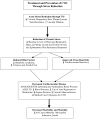Prevention and Treatment of Cardiovascular Disease in Adolescents and Adults through the Transcendental Meditation(®) Program: A Research Review Update
- PMID: 23204989
- PMCID: PMC3510697
- DOI: 10.2174/157340212803530411
Prevention and Treatment of Cardiovascular Disease in Adolescents and Adults through the Transcendental Meditation(®) Program: A Research Review Update
Abstract
The pathogenesis and progression of cardiovascular diseases are thought to be exacerbated by stress. Basic research indicates that the Transcendental Meditation(®) technique produces acute and longitudinal reductions in sympathetic tone and stress reactivity. In adolescents at risk for hypertension, the technique has been found to reduce resting and ambulatory blood pressure, left ventricular mass, cardiovascular reactivity, and to improve school behavior. Research on adults with mild or moderate essential hypertension has reported decreased blood pressure and reduced use of anti-hypertensive medication. The technique has also been reported to decrease symptoms of angina pectoris and carotid atherosclerosis, to reduce cardiovascular risk factors, including alcohol and tobacco use, to markedly reduce medical care utilization for cardiovascular diseases, and to significantly decrease cardiovascular and all-cause morbidity and mortality. These findings have important implications for inclusion of the Transcendental Meditation program in efforts to prevent and treat cardiovascular diseases and their clinical consequences.(®)Transcendental Meditation and TM are trademarks registered in the US. Patent and Trademark Office, licensed to Maharishi Vedic Education Development Corporation and are used with permission.
Conflict of interest statement
The author(s) confirm that this article content has no conflicts of interest.
Figures

References
-
- Heidenreich PA, Trogdon JG, Khavjou OA, et al. Forecasting the future of cardiovascular disease in the United States: a policy statement from the American Heart Association. Circulation. 2011;123:933–944. - PubMed
-
- Daviglus ML, Lloyd-Jones DM, Pirzada A. Preventing cardiovascular disease in the 21st century: therapeutic and preventive implications of current evidence. Am J Cardiovasc Drugs. 2006;6:87–101. - PubMed
-
- Stamler J, Stamler R, Neaton JD. Blood pressure, systolic and diastolic, and cardiovascular risks. US population data. Arch Int Med. 1993;153:598–615. - PubMed
Grants and funding
LinkOut - more resources
Full Text Sources
